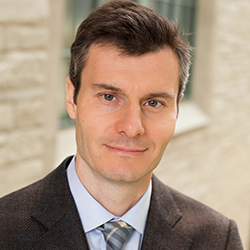September 5, 2018
Improving early cancer detection
A simple and inexpensive procedure – taking a swab – can boost early malignancy detection in seven types of cancer – CBC awardee Vadim Backman, NU, explains
In an interview posted below Vadim Backman, NU, explains novel methodology developed in his lab – nanocytology – analysis of cellular DNA organization at the nanoscale level which allows detection of cells with genome alterations typical to early cancer. Importantly, the cells to be analyzed do not have to come from the affected organ itself, e.g. an analysis of cells obtained by a cheek swab is often sensitive enough to detect cancer in a neighboring organ—in this case—the lung. Backman’s methodology has been clinically tested on a small patient population and has entered the commercialization pipeline. If successfully optimized and implemented, this type of early screening method is expected to substantially decrease cancer mortality. Backman is a co-recipient of a CBC Lever Award (2015). Congratulations!
Cheek swab may help diagnose precancers, early malignancies
NU Chemistry of Life Processes Institute News | August 9, 2018

Source: Flickr
Original article published on July 11, 2018 in Helio, HemOncToday by Rob Volansky
Promising results for a simple cheek swab test to detect precancerous lesions in lung cancer may signify an era of affordable first-line diagnostic procedures, according to researchers at Northwestern University.
If employed to its fullest potential, this type of test could reduce cancer mortality by 50%, Vadim Backman, PhD, Walter Dill Scott professor of biomedical engineering at Northwestern University, and colleagues contend.
An easy and inexpensive method to detect increased cancer risk would allow clinicians to stratify and treat patients at earlier stages of the disease, researchers added.
HemOnc Today spoke with Backman about this approach, the potential impact it could have on cancer mortality, and what must be confirmed in subsequent research.
Question: What prompted you to try this approach?
Answer: We need an inexpensive, noninvasive test for early-stage cancers in the general population that is accurate enough to detect significant lesions. The model for this is the Pap smear. Cervical cancer used to be diagnosed via colposcopy, which was expensive and invasive. The Pap smear changed the equation. It can be done regularly, cheaply and easily. Early diagnosis naturally led to early treatment, and that allowed us to win the war on cervical cancer. We have seen the mortality rate from cervical cancer drop by nearly 20 times. The question is, why have we figured out how to decrease cervical cancer deaths in this way but not deaths from other cancers? The answer is that we’re missing that initial screening test.
Q: Can you elaborate on the approach?
A: It makes a huge difference if you detect, for example, lung cancer at stage IV as opposed to stage I. If you catch it early, survival is around 90%. If you catch it at stage IV, the survival is around 10%. The same is true if you catch other tumors at the precancerous stage. We had to think about the question of how cancer originates and detect those changes. We learned that some of the earliest alterations in carcinogenesis occur in within 3-D structure of the genome in multiple cells throughout the affected organ. However, these alterations are at the nanoscale and were nearly impossible to detect using existing methods. Our technology, called nanocytology, works by harnessing the power of light to examine cells from easily accessible areas of the body. A simple swab of cells from one area, such as the inside of a cheek, can uncover malignancies in a nearby organ — in this case the lungs. When we shine light onto harvested cells, photons bounce off the DNA and proteins in the genome. This allows us to image the organization of the genome at the nanoscale, which gives us an insight into the health of the cells. This allows us to detect changes that are correlated with increased cancer risk, which cannot be done with conventional microscopes. We also were able to use this technology to uncover biomarkers for aggressive forms of cancer. That allows us to individualize treatment recommendations and improve patient outcomes.
Q: After the biomarker, what else are you looking for?
A: There are multiple hallmarks of cancer. One of the most significant is the packing structure of chromatin — the DNA, RNA and proteins — inside cellular nuclei. When chromatin is packed more randomly, cells can explore a greater genomic landscape. This allows cancer to adapt to treatment and evolve to survive. This ability to change in order to resist treatment is one of the underlying hallmarks of cancer. We wanted to look at this transcriptional heterogeneity, which happens at the 20 nanometer to 300 nanometer length scale. With a conventional microscope, you can’t see anything below 200 nanometers, but nanocytology combines microscopy and spectroscopy and allows us to measure chromatin structure. Our approach combines that technology with a new biomarker and new biomarker source.
Q: How is it working so far?
A: We have data in seven types of malignancies. In clinical studies, we brushed cells from the cheek and were able to detect stage I lung cancer. So far, we have tested it in 1,000 patients, with 80% to 90% sensitivity. For colon cancer, we brushed cells from the rectum. It can be done without bowel preparation or cleansing, and it can be done in a primary care setting.
Q: You suggest this could reduce cancer mortality by 50%. That is a fairly bold prediction.
A: This is based on a health economics analysis. The sensitivity of a Pap smear is lower than ours by about 10%, but it still makes such a big difference in mortality. Extrapolating to colon cancer: If patients get a colonoscopy as appropriate, there is a very low chance that they will develop colon cancer. Physicians will detect and remove precancerous lesions. But how do we force all patients to get a colonoscopy? That is practically impossible. It’s also very expensive to society for absolutely everyone to get regular colonoscopies. We already spend $14 billion on them. Also, we just don’t have enough colonoscopists and endoscopists. Beyond that, patients just don’t like getting colonoscopies because they are invasive and unpleasant. The smart way to do it is not to screen everybody with a colonoscopy. A better way is to identify patients who are not at high risk by using an initial test. That initial test can be our nanocytology test. If you run the numbers, then you pretty much obliterate colon cancer. If we could apply the same test for lung cancer, the same would be true. Lung and colon are the two biggest cancer killers in the country. If you add this up, you get very close to a 50% reduction in mortality.
Q: So these numbers are based on extrapolation and still require validation?
A: Of course. It’s not even in clinical practice yet. It needs to be commercialized and adopted by the entire health care system. Remember, it took several years for the Pap smear to be adopted by everybody. That needs to happen first. If we only offer these screens at our center, we obviously won’t reach our goal.
Q: Is there a timeline for commercializing the approach and getting it into clinical practice ?
A: I can’t speculate on that. Commercialization is a complex process that depends on fundraising and whether insurance companies will pay for it. The cost of our nanocytology test is small — less than $100. But all of this is beyond my personal control. Even though we have data in seven cancers, not every cancer is screenable. In less prevalent cancers, such as pancreatic or ovarian cancers, the accuracy of the test would need to be very high.
Q: What is your next step?
A: The lung test is the most advanced now. The next step would be a larger-scale trial. We are working with a company to commercialize this test.
Source:
Adapted (with modifications) from the NU Chemistry of Life Processes Institute News, published on August 9, 2018.
Featured scientist(s) with ties to cbc:
Vadim Backman, NU
CBC Lever Award (2015):
PIs: Vadim Backman (NU), Lucy Godley (UChicago) and Jack Kaplan (UIC) for the project:
▸ Chicago Center for Physical Science-Oncology Innovation and Translation
Related:
November 7, 2017
▸ Highlighting progress in cancer research supported in part through a CBC Lever Award. Spotlight on Vadim Backman, Tom O’Halloran and Andrew Mazar.
September 21, 2016
▸ Researchers Discover that DNA Naturally Fluoresces

